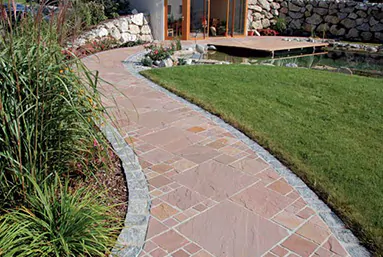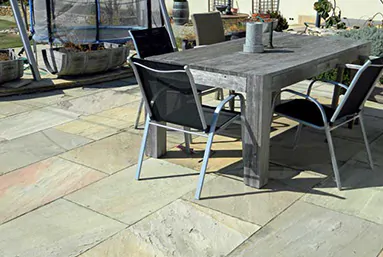Indian sandstone is always considered the most preferred natural stone for patio projects worldwide. Thanks to its earthy color tones, superior durability, and sturdiness, this stone exhibits excellent resistance to adverse elements such as high heat, bitter cold, moisture, rain, and others. Using Indian sandstone for patio projects means you bring high levels of versatility, durability, and beauty to exteriors. Let’s get to know more about using sandstone for such projects.
What does sandstone mean?
Sandstone comes under the category of clastic sedimentary rocks and is composed of sand-sized silicate grains. Sandstone comes in different varieties. This natural stone is primarily made up of feldspar, quartz, and several other minerals such as mica, clay, or calcite. According to experts, sandstone forms nearly 20-25% of all sedimentary rocks available on the earth.
Clastic rocks are not created by chemical changes or subterranean heat and pressure; rather, they are generated from pre-existing components.
Sandstone is deposited by rivers, seas, and arid areas to form sandstone. Groundwater minerals subsequently compress and gradually cement the grains together. Depending on their makeup and formation location, the resulting sandstones can have a wide range of colors. Tan, brown, red, yellow, grey, pink, white, and black are the most prevalent hues.
What are the applications of sandstone?


Sandstone has been used in artwork, tools, cathedrals, temples, homes, and other structures since prehistoric times. These days, it’s also employed as paving and cladding for building facades. Sandstone can also be crushed to create gravel or aggregate.
What are the benefits of sandstone?
The use of Indian sandstone for patios and other types of paving has grown significantly in popularity. It has multiple advantages and functions well in a range of environments.
- Manufactured stone cannot equal the visually attractive natural appearance of beautiful sandstone.
- Because sandstone comes in so many colors, there is a type to fit any setting or type of property.
- Sandstone’s color is more pronounced when it’s wet.
- Unlike artificial alternatives, the color of sealed sandstone remains constant when exposed to sunshine.
- Stone produced naturally over millions of years, sandstone is a hard substance.
- Sandstone is simple to work with despite its strength.
- Even under damp conditions, riven sandstone remains non-slip.
- Compared to many other natural and artificial materials, sandstone is less likely to crack.
Laying Indian Sandstone Patio Correctly
Although sandstone is an exquisite material, it needs to be put properly to produce a patio that complements the stone’s exquisite looks and will endure over time. Here’s how to install a patio made of sandstone:
- Make sure the patio’s location is firm, level, and well-drained.
- Make a spray paint mark on the area.
- Excavate the area to a minimum depth of 125 mm, in addition to the paving’s depth.
- Take out all the plants.
- If the patio is next to a structure, make sure the finished patio’s surface is at least 150 mm below the house’s damp course.
- To ensure that the area is level, use strings, and rake any areas that need to be leveled.
- Roll the region to make it more compact.
- After adding at least 50 mm of sub-base (aggregate), level the surface and compact the dirt.
- Compact the additional layer of sub-base (at least 50 mm).
- To facilitate the runoff of rainfall, make sure the land slopes slightly away from the home.
- To get rid of dirt and dust, wash the slabs.

- Use a fine mortar slurry or a specialized primer to prime the stone’s backs.
- Mix four parts sand to one part cement with water to make a mortar.
- Place a 50 mm mortar bed, little by small.
- Place the stones 8–10 mm apart in the mortar bed, then gently tap them with a rubber mallet.
- Give the bed a full day to settle.
- Before stepping on the patio, let it settle for at least a day.
Common Mistakes To Avoid While Laying Sandstone Patio
It is easy to rush or take short cuts when laying a patio because it is a labor-intensive task. However, disregarding details will inevitably lead to subpar outcomes. Hiring a qualified and professional contractor to finish the job for you is undoubtedly the finest option. Before hiring a contractor, always request to view samples of their prior work; you don’t want to fall prey to dishonest business methods or subpar construction. When working with sandstone, the following mistakes are most frequently made:
- Poor drainage: Without a doubt, failing to make sure the patio is properly drained is the most frequent mistake made while putting sandstone. A competent builder will install the patio properly and, if necessary, provide drainage channels.
- Incorrect slab size: Your contractor ought to be able to provide you advice on what size slabs would be best for your area. While large slabs could prevent you from creating the arrangement or pattern you want, little slabs can make small patios feel even smaller.
- Selecting the incorrect color: make sure to always inspect the color of wet slabs because wet sandstone can have a drastically different tint and may not meet your desired aesthetic standards.
- Not laying a whole mortar bed; a complete mortar bed is necessary instead of spotting.
- Slabs can be laid upside down; some will have a smooth side and a textured side. There will be loose joints if all of the slabs are laid with the textured side up. Inverting a portion of the slabs will result in loose joints and an uneven appearance.
Does sandstone need sealing?
Millions of years go by before sandstone is produced. It is made of a strong, weather-resistant material that won’t fade or degrade easily. But because it is a porous stone, it will take in dirt, moisture, and other things that will discolor it.
Although sealing sandstone is not necessary, it will help to prolong the appearance of a newly installed patio by preventing further deterioration. Additionally, sealant will stop spill stains, which can be very difficult to erase. There are sealants that enhance color and those that are invisible.
How can I maintain an Indian sandstone patio?
All patios, no matter how good or how neatly laid, need some simple upkeep to stay looking their best. A sandstone patio will eventually crumble if it is not maintained. Fortunately, revitalizing your paving is simple.
It is advisable to give your patio a wash whenever you have a moment. All you need to clean your slabs is a brush, soap, and water. The surrounding plants, foot movement, and dirt will all affect the color and texture of the patio paving. You can wash the stones with soapy water or dilute white bleach to get rid of the dirt.
It will take some elbow grease to remove mosses, algae (green), or lichens (black or white blotches) that have affected your patio. However, since chemical treatments like fungicides can cause the sandstone to become discolored, it is recommended to avoid using them to speed up the process.
Unless the paving features resin grouting, avoid jet washing your patio on high power as this can erode the stone and ruin the grout.
A sealed Indian sandstone patio needs to be resealed every one to two years in addition to routine maintenance. Repairing any cracked mortar should be done right away.
The Conclusion
Selecting Indian sandstone patio makes a lot of sense. With this gorgeous, adaptable, and long-lasting material, you may select from a variety of slab sizes, colors, and textures. Large, tiny, homogeneous, freeform, or raised patios can be designed with sandstone in a formal or informal setting. Gorgeous sandstone has countless design options.
